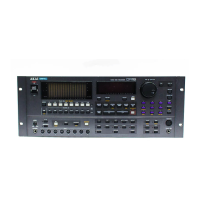
Do you have a question about the Akai DR16 pro and is the answer not in the manual?
| Number of Tracks/Channels | 16 |
|---|---|
| Sampling Rate | 44.1 kHz |
| Bit Depth | 16-bit |
| Storage Type | Hard Disk Drive (HDD) |
| MIDI I/O | Yes |
| Operating System | Proprietary |
| Video Input | No |
| Video Output | No |
| Network Connectivity | No |
| Power Supply | AC Adapter |
Explains what the DR16pro is, a 16-track digital hard disk recorder and editor.
Lists the key features and capabilities of the DR16pro, such as multitrack recording and digital mixing.
Provides a detailed overview of the physical controls and features on the front of the DR16pro unit.
Details the various connectors and ports located on the back of the DR16pro unit.
Explains the different operational modes of the DR16pro, such as Normal, Sub-Menu, Mix, and Edit modes.
Describes the DR16pro's display and operational elements, including status indicators and sub-menus.
Details how to input and display desired time values for locating and setting points within recordings.
Explains how to set 'in' and 'out' points, crucial for auto punch-in/out and editing operations.
Provides guidelines for positioning the DR16pro for optimal performance and ventilation.
Instructions for connecting the power supply and operating the power switch for the DR16pro.
Explains the importance of setting the sampling frequency and its impact on audio quality and recording time.
Details how to select and configure analog and digital input sources for recording.
Covers manual, footswitch, and automatic punch-in/out methods for recording.
Describes the various analog and digital outputs available for playback and monitoring.
Instructions for initiating and terminating playback operations using the unit's controls.
Explains the function of special keys like TO, OVER, FROM, and IN->OUT for precise playback control.
Introduces the 16-channel digital mixer and its output assignment modes (MULT, MIX).
Details how to adjust level, pan, and send settings for each mixer channel.
Covers storing, recalling, and mapping mixer snapshots for automated mixing.
Guides users through the process of creating new project files on the hard disk.
Explains how to load existing project files from connected hard disks.
Provides instructions for deleting project files to manage disk space.
Describes how to locate to precise points using time entry and navigation controls.
Explains storing and recalling up to nine direct locate points using the numeric keypad.
Details storing and recalling up to 100 stack locate points using a two-digit number.
Introduces the nine available editing functions like copy, move, insert, and erase.
Explains how to undo edits, allowing for experimentation and comparison.
Describes how to copy sections of audio to other tracks or locations.
Details how to move sections of audio, leaving a gap in the source track.
Provides guidance on selecting compatible and suitable hard disks for the DR16pro.
Explains SCSI connection principles, cables, IDs, and termination requirements.
Covers the essential processes of formatting and erasing hard disks for the DR16pro.
Instructions for backing up data to a SCSI tape drive for safety.
Details the process of restoring backed-up data from a SCSI tape drive.
Explains how to load data from a DAT recorder for backup or transfer.
Covers setting up synchronization using SMPTE/EBU timecode.
Explains how to synchronize with external MIDI devices using MTC, MMC, or MIDI Clock.
Details master/slave operation using the RS422 interface.
Guides users on creating tempo maps for synchronized playback with sequencers.
Explains how to create beat maps, specifying time signatures for songs.
Covers selecting, naming, and setting the start time for songs.
Allows control over features like AKAINET ID, Flash ROM save/load, and display settings.
Details how to assign MIDI controllers for various functions like mute, level, pan, and sends.
Provides detailed technical specifications for the DR16pro.
Lists and explains various system error codes for troubleshooting.
Details MIDI message transmission and reception for controller and system functions.